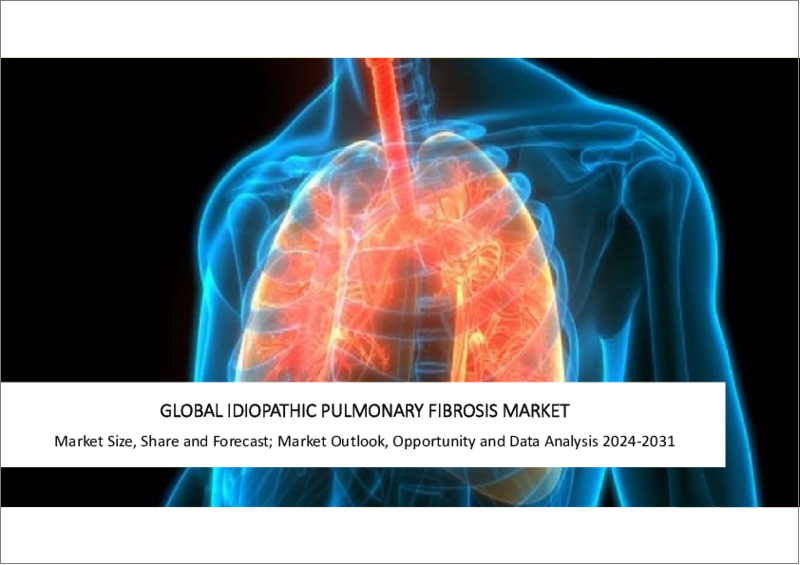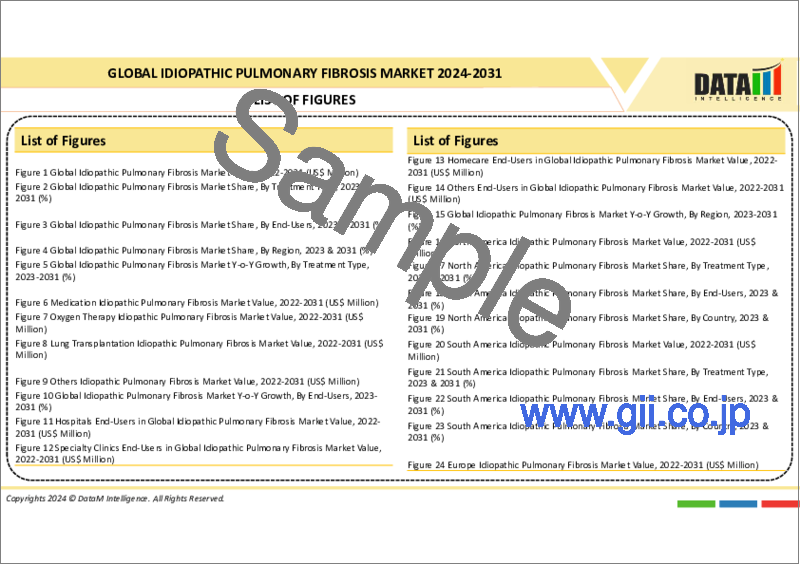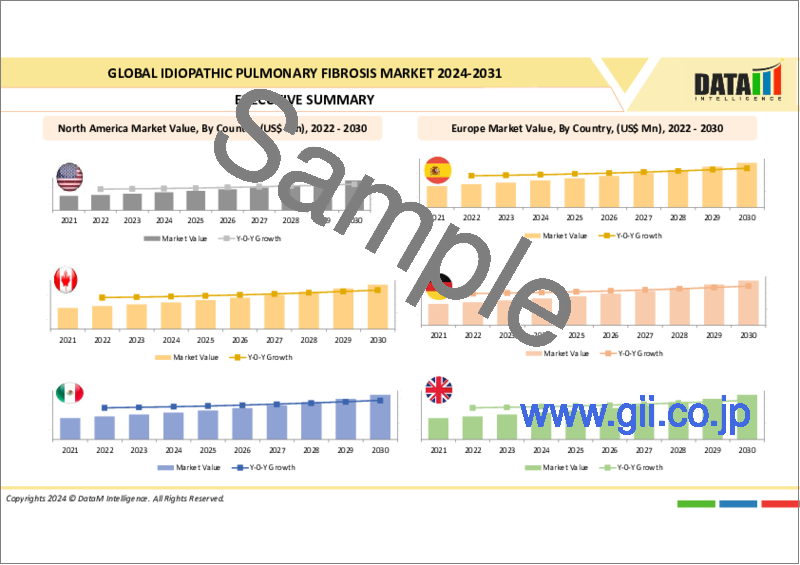|
|
市場調査レポート
商品コード
1290355
特発性肺線維症の世界市場:2023-2030Global Idiopathic Pulmonary Fibrosis Market - 2023-2030 |
||||||
カスタマイズ可能
適宜更新あり
|
|||||||
| 特発性肺線維症の世界市場:2023-2030 |
|
出版日: 2023年06月12日
発行: DataM Intelligence
ページ情報: 英文 195 Pages
納期: 即日から翌営業日
|
- 全表示
- 概要
- 目次
市場概要
特発性肺線維症の世界市場規模は2022年に21億8,440万米ドルに達し、2030年には最大46億1,430万米ドルに達することで有利な成長が予測されます。世界の特発性肺線維症市場は、予測期間(2023年~2030年)に10.1%のCAGRを示すと予測されています。主要な市場動向は、強力なパイプライン医薬品に対する需要の高まりです。
例えば、2022年3月、Blade Therapeutics社は、IPFおよびその他の線維性疾患に対して臨床開発中の治験用非競合オートタキシン阻害剤であるcudetaxestatの差別化特性を発表しました。Cudetaxestatは、IPFおよび全身性硬化症の治療薬として、オーファンドラッグ指定を取得しています。
特発性肺線維症(IPF)は、肺実質の瘢痕化を特徴とする、原因不明の慢性進行性疾患です。加齢に伴う疾患であり、IPFにおける線維化のメカニズムは未だ解明されていませんが、遺伝的素因による肺胞上皮の微小損傷の再発と、過剰なコラーゲン沈着を特徴とする異常な修復反応による疾病発症の概念が有力視されています。
世界の特発性肺線維症市場は、IPF治療薬の臨床試験の増加、高齢化率の上昇、承認済みの治療薬の入手可能性、パイプラインや治験薬の増加、意識の高まりと早期診断、研究技術の進歩といった要因によって牽引されています。
例えば、2023年5月、世界のバイオ医薬品企業であるBristol Myers Squibb社は、ファーストインクラスの経口リゾホスファチジン酸受容体1(LPA1)拮抗薬の候補であるBMS-986278を特発性肺線維症患者で評価した第2相試験の結果を発表しました。本試験では、BMS-986278の1日2回、26週間にわたる60mgの投与により、プラセボと比較して、予測強制生命維持能力(ppFVC)の低下率が62%減少することが示されました。
市場力学
承認された治療薬の入手可能性
承認済みの治療薬が入手可能であることが、予測期間中の市場シェアを押し上げる主要因となっています。ピルフェニドンやニンテダニブなどの承認されたIPF治療薬は、疾患の進行を遅らせ、肺機能を維持し、急性増悪を減少させることが示されています。これらの薬剤は、肺の根本的な線維化プロセスを標的とし、疾患修飾のアプローチを提供します。これらの治療薬が利用可能になったことで、IPFの管理に革命が起こり、ヘルスケアプロバイダーはより効果的で的を絞った治療戦略を提供することができるようになりました。
例えば、2022年7月、ピュアテックは、特発性肺線維症(IPF)患者を対象とした実験的治療薬LYT-100の安全性と有効性を評価する臨床試験を開始しました。LYT-100の活性剤であるドゥピルフェニドンは、ジェネンテックが販売するIPF治療薬エスブリエット(ピルフェニドン)を化学修飾したもので、承認されています。
限られた治療選択肢と治療別副作用
IPFには承認された治療薬がありますが、利用可能な治療法の選択肢は依然として限られています。ピルフェニドンとニンテダニブが治療の主役ですが、患者さんによっては十分な効果が得られなかったり、耐え難い副作用に見舞われたりすることがあります。患者やヘルスケアプロバイダーはより多様で効果的な治療法を求めているため、代替治療法の欠如は市場成長の妨げとなります。
ピルフェニドンやニンテダニブなど、利用可能なIPF治療薬は、一部の患者にとって困難な副作用を伴います。これらの副作用には、胃腸症状、肝機能異常、皮膚の発疹などが含まれることがあります。副作用の存在は、治療の中止や治療開始への消極性につながり、市場の成長を制限する可能性があります。
COVID-19の影響分析
COVID-19の流行は、特発性肺線維症市場を含むヘルスケア産業に大きな影響を与えています。ピルフェニドンやニンテダニブなど、利用可能なIPF治療薬は、一部の患者にとって困難な副作用を伴うものです。これらの副作用には、胃腸症状、肝機能異常、皮膚の発疹などが含まれることがあります。副作用の存在は、治療の中止や治療開始への消極性につながり、市場の成長を制限する可能性があります。
IPF治療薬や治療法の臨床試験もパンデミックの影響を受けています。安全性への懸念、リソースの制限、患者募集の困難さなどが原因で、多くの臨床試験が一時的に中止または延期されました。臨床試験の混乱は、潜在的な新しい治療法の進捗を遅らせ、その開発スケジュールを延長させました。
ロシア・ウクライナ紛争分析
ロシア・ウクライナ紛争は、特発性肺線維症市場に大きな影響を及ぼしています。紛争とその余波は、ヘルスケア・インフラと研究能力に負担をかける可能性があります。資源の流用、インフラの破壊、頭脳流出により、研究開発、臨床試験、IPFの専門医療へのアクセスなどの能力が妨げられる可能性があります。その結果、IPFの治療法の進歩が遅れ、最先端の治療法の利用が制限される可能性があります。
紛争とその結果は、IPFのような慢性疾患から注意と資源をそらすことになりかねません。危機的状況下では、ヘルスケアシステムは、緊急の医療ニーズ、緊急対応、急性期医療サービスを優先させることが多いです。このような焦点の転換により、IPFのような慢性疾患の管理や調査への関心が低下する可能性があります。
目次
第1章 調査手法とスコープ
- 調査手法
- 調査目的および調査範囲
第2章 定義と概要
第3章 エグゼクティブサマリー
- 治療法別スニペット
- エンドユーザー別スニペット
- 地域別スニペット
第4章 市場力学
- 影響要因
- 促進要因
- 承認された治療法の利用可能性
- 高齢化率の上昇
- 抑制要因
- 治療法の選択肢の少なさ
- 治療別副作用
- 機会
- 調査技術や治療方法の進歩
- 影響分析
- 促進要因
第5章 産業分析
- ポーターの5フォース分析
- サプライチェーン分析
- 価格分析
- 法規制の分析
第6章 COVID-19の分析
- COVID-19の分析
- COVID-19の前のシナリオ
- COVID-19実施中のシナリオ
- COVID-19後のシナリオ
- COVID-19の中での価格・ダイナミクス
- 需給スペクトル
- パンデミック時の市場に関連する政府の取り組み
- メーカーの戦略的な取り組み
- サマリー
第7章 治療法別
- 治療薬
- ニンテダニブ
- ピルフェニドン
- 酸素療法
- 肺リハビリテーション
- 肺移植
- その他
第8章 エンドユーザー別
- 病院
- 診療所
- その他
第9章 地域別
- 北米
- 米国
- カナダ
- メキシコ
- 欧州
- ドイツ
- 英国
- フランス
- イタリア
- スペイン
- その他欧州
- 南米
- ブラジル
- アルゼンチン
- その他南米地域
- アジア太平洋地域
- 中国
- インド
- 日本
- オーストラリア
- その他アジア太平洋地域
- 中東・アフリカ地域
第10章 競合情勢
- 競合シナリオ
- 市況/シェア分析
- M&A(合併・買収)分析
第11章 企業プロファイル
- Roche Holdings AG
- 会社概要
- 製品ポートフォリオと説明
- 財務概要
- 主な発展状況
- Boehringer Ingelheim GmbH
- Genentech Inc.
- FibroGen Inc.
- Galapagos NV
- MEDICINOVA INC.
- Bristol Myers Squibb Company
- Biogen Inc.
- AstraZeneca PLC
- Novartis International AG.
第12章 付録
Market Overview
The Global Idiopathic Pulmonary Fibrosis Market size reached US$ 2,184.4 million in 2022 and is projected to witness lucrative growth by reaching up to US$ 4,614.3 million by 2030. The global idiopathic pulmonary fibrosis market is expected to exhibit a CAGR of 10.1% during the forecast period (2023-2030). The key market trend is the increasing demand for strong pipeline drugs.
For instance, in March 2022, Blade Therapeutics announced the differentiating characteristics of cudetaxestat, an investigational non-competitive autotaxin inhibitor in clinical development for IPF and other fibrotic diseases. Cudetaxestat has been granted orphan drug designations in the treatment of IPF and systemic sclerosis.
Idiopathic pulmonary fibrosis (IPF) is a chronic progressive disease of unknown cause characterized by scarring of the lung parenchyma. It is an age-related disorder and the mechanisms of fibrosis in IPF remain elusive, with favored concepts of disease pathogenesis involving recurrent micro-injuries to a genetically predisposed alveolar epithelium followed by an aberrant reparative response characterized by excessive collagen deposition.
The global idiopathic pulmonary fibrosis market is driven by factors such as the increasing clinical trials of IPF drugs, the rising aging population, the availability of approved therapies, the growing pipeline and investigational drugs, rising awareness & early diagnosis, and advancements in research techniques.
For instance, in May 2023, Bristol Myers Squibb, a global biopharmaceutical company announced results from a Phase 2 study evaluating BMS-986278, a potential first-in-class, oral, lysophosphatidic acid receptor 1 (LPA1) antagonist, in patients with idiopathic pulmonary fibrosis. The study showed that twice-daily administration of 60 mg of BMS-986278 over 26 weeks reduced the rate of decline in percent predicted forced vital capacity (ppFVC) by 62% compared to placebo.
Market Dynamics
Availability of Approved Therapies
The availability of approved therapies is the major factor driving the market share during the forecast period. Approved IPF therapies, such as pirfenidone and nintedanib, have been shown to slow disease progression, preserve lung function, and reduce acute exacerbations. These medications target the underlying fibrotic processes in the lungs, providing a disease-modifying approach. The availability of these therapies has revolutionized IPF management, allowing healthcare providers to offer more effective and targeted treatment strategies.
For instance, in July 2022, PureTech initiated a clinical study to evaluate the safety and effectiveness of its experimental therapy LYT-100 in people with idiopathic pulmonary fibrosis (IPF). The active agent in LYT-100, called deupirfenidone, is a chemically-modified version of the approved IPF treatment Esbriet (pirfenidone) marketed by Genentech.
Limited Treatment Options and Side Effects of the Treatment
While there are approved therapies for IPF, the number of available treatment options remains limited. Pirfenidone and nintedanib are the mainstays of treatment, but some patients may not respond adequately or may experience intolerable side effects. The lack of alternative treatment options hampers market growth as patients and healthcare providers seek more diverse and effective therapies.
The available IPF treatments, such as pirfenidone and nintedanib, are associated with side effects that can be challenging for some patients. These side effects may include gastrointestinal symptoms, liver abnormalities, skin rashes, and others. The presence of side effects can lead to treatment discontinuation or reluctance to initiate therapy, which can limit market growth.
COVID-19 Impact Analysis
The COVID-19 pandemic has had a profound impact on the healthcare industry, including the idiopathic pulmonary fibrosis market. The available IPF treatments, such as pirfenidone and nintedanib, are associated with side effects that can be challenging for some patients. These side effects may include gastrointestinal symptoms, liver abnormalities, skin rashes, and others. The presence of side effects can lead to treatment discontinuation or reluctance to initiate therapy, which can limit market growth.
Clinical trials for IPF treatments and therapies were also affected by the pandemic. Many trials were temporarily halted or delayed due to safety concerns, limited resources, and difficulties in patient recruitment. The disruption in clinical trials slowed down the progress of potential new treatments and extended the timeline for their development.
Russia-Ukraine Conflict Analysis
The Russia-Ukraine conflict has had a significant impact on the idiopathic pulmonary fibrosis market. The conflict and its aftermath can strain the healthcare infrastructure and research capabilities. Diverted resources, destruction of infrastructure, and brain drain could hinder the capacity for research and development, clinical trials, and access to specialized IPF care. This can slow down advancements in IPF treatment options and limit the availability of cutting-edge therapies.
The conflict and its consequences can divert attention and resources away from chronic diseases like IPF. In times of crisis, healthcare systems often prioritize immediate health needs, emergency response, and acute care services. This shift in focus may result in reduced attention to the management and research of chronic conditions like IPF.
Segment Analysis
The global idiopathic pulmonary fibrosis market is segmented based on treatment, end-user, and region.
Based on Treatment, the Drugs Segment is Expected to Dominate the Market Share
The market for drugs segment held 45.3% of the global idiopathic pulmonary fibrosis market share in 2022. The drugs segment continues to see significant research and development activities. Pharmaceutical companies are investing in the development of novel drug candidates that target different aspects of IPF pathophysiology. This ongoing innovation in drug development further strengthens the prominence of the drugs segment in the IPF market.
For instance, in October 2022, Boehringer Ingelheim, a leading research-driven biopharmaceutical company, announced that the first U.S. patient enrolled in FIBRONEER IPF drug, a global Phase III trial evaluating BI 1015550, an investigational phosphodiesterase 4B (PDE4B) inhibitor, in people living with idiopathic pulmonary fibrosis (IPF).
Geographical Analysis
North America Holds the Largest Market Share Due to the High Disease Burden and Availability of Approved Therapies
North America held 40.2% market share for the idiopathic pulmonary fibrosis market in 2022 due to the high disease burden and availability of approved therapies. North America, particularly the United States, has a high prevalence of IPF compared to other regions. The region's aging population, environmental factors, and lifestyle contribute to the higher disease burden. The significant number of IPF patients in North America drives the demand for IPF treatments and contributes to the region's market dominance.
North America has been at the forefront of research and development in IPF treatment. The region has witnessed early approvals of key therapies for IPF, including pirfenidone and nintedanib. The availability of these approved therapies in North America has significantly contributed to the market growth, as patients have access to effective treatment options.
Competitive Landscape
The major global players in the market include: Roche Holdings AG, Boehringer Ingelheim GmbH, Genentech Inc., FibroGen Inc., Galapagos NV, MEDICINOVA INC., Bristol Myers Squibb Company, Biogen Inc., AstraZeneca PLC, and Novartis International AG.
Why Purchase the Report?
- To visualize the global idiopathic pulmonary fibrosis market segmentation based on treatment, end-user, and region and understand key commercial assets and players.
- Identify commercial opportunities by analyzing trends and co-development.
- Excel data sheet with numerous data points of idiopathic pulmonary fibrosis market-level with all segments.
- PDF report consists of a comprehensive analysis after exhaustive qualitative interviews and an in-depth study.
- Product mapping available as Excel consisting of key products of all the major players.
The global idiopathic pulmonary fibrosis market report would provide approximately 54 tables, 46 figures, and 195 Pages.
Target Audience 2023
- Manufacturers/ Buyers
- Industry Investors/Investment Bankers
- Research Professionals
- Emerging Companies
Table of Contents
1. Methodology and Scope
- 1.1. Research Methodology
- 1.2. Research Objective and Scope of the Report
2. Definition and Overview
3. Executive Summary
- 3.1. Snippet by Treatment
- 3.2. Snippet by End-User
- 3.3. Snippet by Region
4. Dynamics
- 4.1. Impacting Factors
- 4.1.1. Drivers
- 4.1.1.1. Availability of Approved Therapies
- 4.1.1.2. Rising Aging Population
- 4.1.2. Restraints
- 4.1.2.1. Limited Treatment Options
- 4.1.2.2. Side Effects of the Treatment
- 4.1.3. Opportunity
- 4.1.3.1. Advancements in Research Techniques and Treatment Procedures
- 4.1.4. Impact Analysis
- 4.1.1. Drivers
5. Industry Analysis
- 5.1. Porter's 5 Forces Analysis
- 5.2. Supply Chain Analysis
- 5.3. Pricing Analysis
- 5.4. Regulatory Analysis
6. COVID-19 Analysis
- 6.1. Analysis of COVID-19
- 6.1.1. Scenario Before COVID-19
- 6.1.2. Scenario During COVID-19
- 6.1.3. Scenario Post COVID-19
- 6.2. Pricing Dynamics Amid COVID-19
- 6.3. Demand-Supply Spectrum
- 6.4. Government Initiatives Related to the Market During the Pandemic
- 6.5. Manufacturer's Strategic Initiatives
- 6.6. Conclusion
7. By Treatment
- 7.1. Introduction
- 7.1.1. Market Size Analysis and Y-o-Y Growth Analysis (%), By Treatment
- 7.1.2. Market Attractiveness Index, By Treatment
- 7.2. Drugs*
- 7.2.1. Introduction
- 7.2.2. Market Size Analysis and Y-o-Y Growth Analysis (%)
- 7.2.3. Nintedanib
- 7.2.4. Pirfenidone
- 7.3. Oxygen Therapy
- 7.4. Pulmonary Rehabilitation
- 7.5. Lung Transplant
- 7.6. Others
8. By End-User
- 8.1. Introduction
- 8.1.1. Market Size Analysis and Y-o-Y Growth Analysis (%), By End-User
- 8.1.2. Market Attractiveness Index, By End-User
- 8.2. Hospitals*
- 8.2.1. Introduction
- 8.2.2. Market Size Analysis and Y-o-Y Growth Analysis (%)
- 8.3. Clinics
- 8.4. Others
9. By Region
- 9.1. Introduction
- 9.1.1. Market Size Analysis and Y-o-Y Growth Analysis (%), By Region
- 9.1.2. Market Attractiveness Index, By Region
- 9.2. North America
- 9.2.1. Introduction
- 9.2.2. Key Region-Specific Dynamics
- 9.2.3. Market Size Analysis and Y-o-Y Growth Analysis (%), By Treatment
- 9.2.4. Market Size Analysis and Y-o-Y Growth Analysis (%), By End-User
- 9.2.5. Market Size Analysis and Y-o-Y Growth Analysis (%), By Country
- 9.2.5.1. The U.S.
- 9.2.5.2. Canada
- 9.2.5.3. Mexico
- 9.3. Europe
- 9.3.1. Introduction
- 9.3.2. Key Region-Specific Dynamics
- 9.3.3. Market Size Analysis and Y-o-Y Growth Analysis (%), By Treatment
- 9.3.4. Market Size Analysis and Y-o-Y Growth Analysis (%), By End-User
- 9.3.5. Market Size Analysis and Y-o-Y Growth Analysis (%), By Country
- 9.3.5.1. Germany
- 9.3.5.2. The UK
- 9.3.5.3. France
- 9.3.5.4. Italy
- 9.3.5.5. Spain
- 9.3.5.6. Rest of Europe
- 9.4. South America
- 9.4.1. Introduction
- 9.4.2. Key Region-Specific Dynamics
- 9.4.3. Market Size Analysis and Y-o-Y Growth Analysis (%), By Treatment
- 9.4.4. Market Size Analysis and Y-o-Y Growth Analysis (%), By End-User
- 9.4.5. Market Size Analysis and Y-o-Y Growth Analysis (%), By Country
- 9.4.5.1. Brazil
- 9.4.5.2. Argentina
- 9.4.5.3. Rest of South America
- 9.5. Asia-Pacific
- 9.5.1. Introduction
- 9.5.2. Key Region-Specific Dynamics
- 9.5.3. Market Size Analysis and Y-o-Y Growth Analysis (%), By Treatment
- 9.5.4. Market Size Analysis and Y-o-Y Growth Analysis (%), By End-User
- 9.5.5. Market Size Analysis and Y-o-Y Growth Analysis (%), By Country
- 9.5.5.1. China
- 9.5.5.2. India
- 9.5.5.3. Japan
- 9.5.5.4. Australia
- 9.5.5.5. Rest of Asia-Pacific
- 9.6. Middle East and Africa
- 9.6.1. Introduction
- 9.6.2. Key Region-Specific Dynamics
- 9.6.3. Market Size Analysis and Y-o-Y Growth Analysis (%), By Treatment
- 9.6.4. Market Size Analysis and Y-o-Y Growth Analysis (%), By End-User
10. Competitive Landscape
- 10.1. Competitive Scenario
- 10.2. Market Positioning/Share Analysis
- 10.3. Mergers and Acquisitions Analysis
11. Company Profiles
- 11.1. Roche Holdings AG*
- 11.1.1. Company Overview
- 11.1.2. Product Portfolio and Description
- 11.1.3. Financial Overview
- 11.1.4. Key Developments
- 11.2. Boehringer Ingelheim GmbH
- 11.3. Genentech Inc.
- 11.4. FibroGen Inc.
- 11.5. Galapagos NV
- 11.6. MEDICINOVA INC.
- 11.7. Bristol Myers Squibb Company
- 11.8. Biogen Inc.
- 11.9. AstraZeneca PLC
- 11.10. Novartis International AG.
LIST NOT EXHAUSTIVE
12. Appendix
- 12.1. About Us and Services
- 12.2. Contact Us





